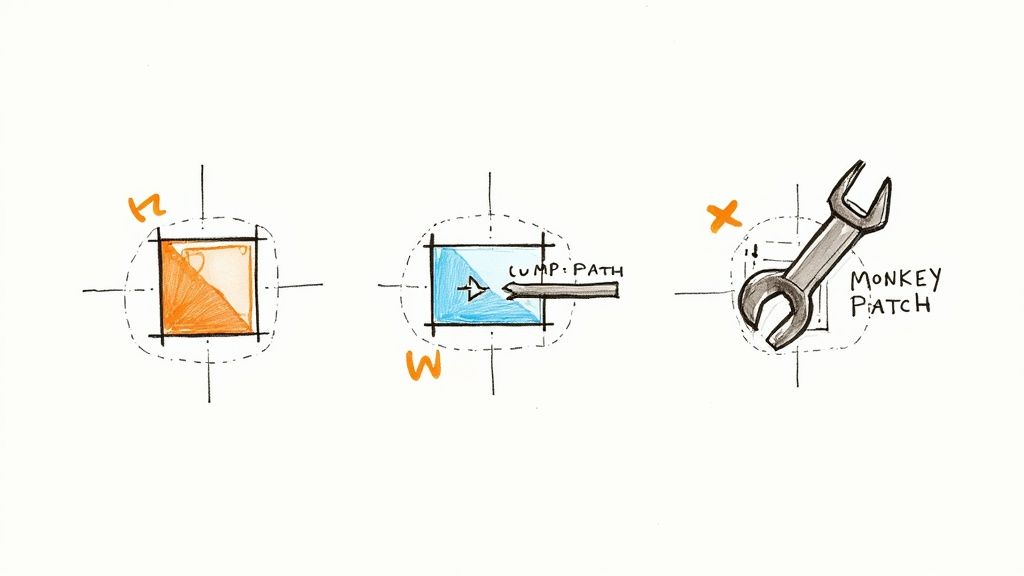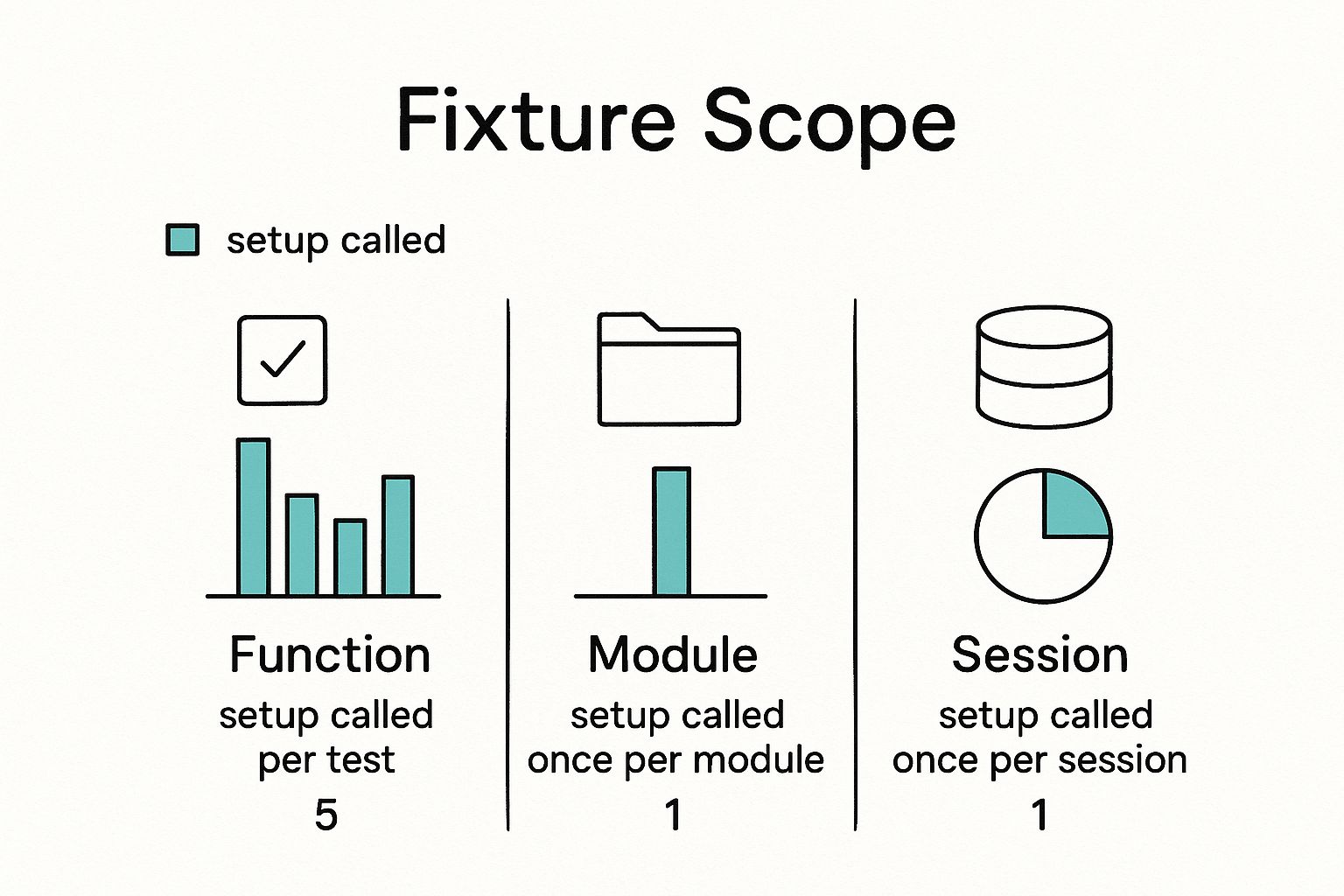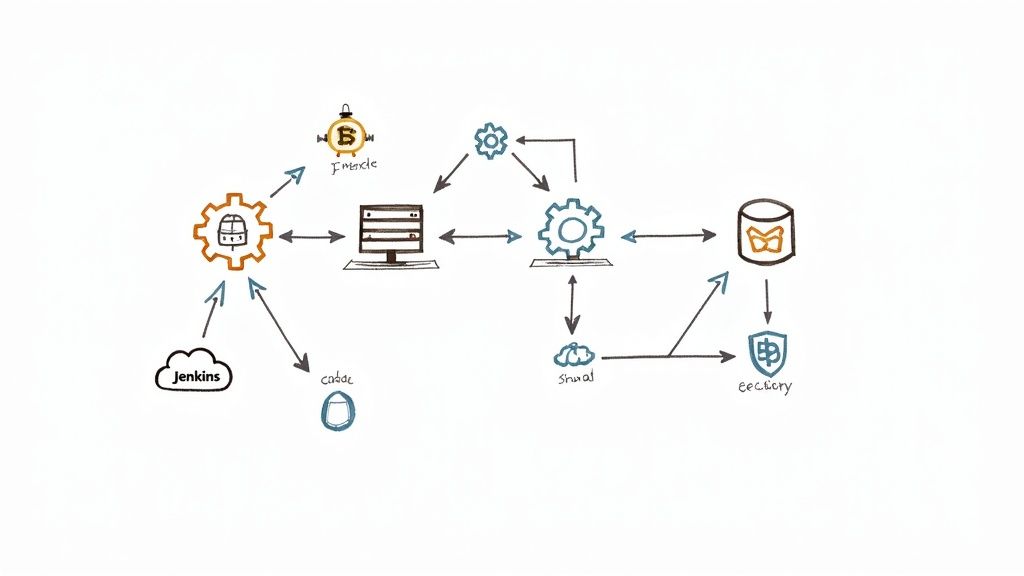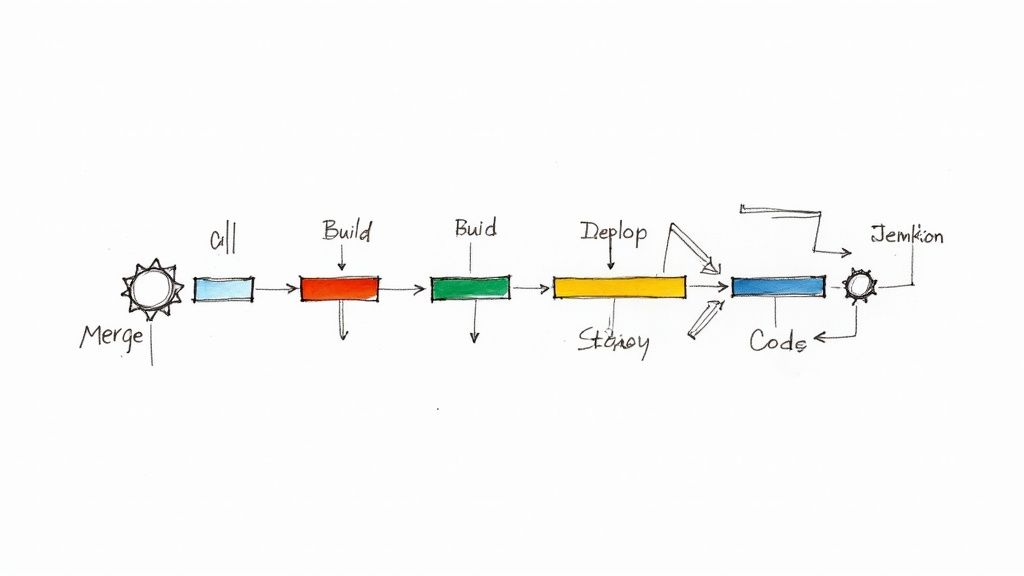Master Fixture Python: Improve Testing Efficiency Today

The Power of Python Fixtures: Transform Your Testing Approach
Tired of repetitive test setups and tests that break easily? Many developers grapple with these common testing issues, impacting code quality and project timelines. Python fixtures, however, provide a robust solution for improving your testing approach and building more resilient, maintainable test suites. Fixtures have changed how developers approach testing by enabling them to manage complex test dependencies and significantly reduce code duplication. They address core testing challenges, ensuring test isolation, facilitating complex data preparation, and simplifying resource management.
What Exactly Are Fixtures?
A Python fixture is a function decorated with @pytest.fixture that provides reusable resources or performs setup and teardown operations for your tests. Consider them pre-built components that your tests can access as needed. You can define a fixture to establish a database connection, populate it with test data, and dismantle it after the test completes. This prevents repeating these steps in every test needing database interaction, promoting code reusability and consistency. For instance, if several tests require a specific user account, a fixture can set up that account once and provide it to each test.
The Pytest Advantage
The pytest framework (Pytest) has been crucial in popularizing fixtures in Python testing. Pytest's embrace of fixtures has reshaped how many developers write and structure their Python tests. The widespread use of pytest is largely due to its robust fixture system. The framework has been widely adopted since its 2004 launch, with over 19 million downloads in April 2023 alone. As of 2025, fixtures remain central to pytest's success, cited as the primary reason for adoption in 68% of surveyed organizations. This highlights the impact and enduring relevance of fixtures in Python testing. Learn more on BrowserStack's guide to top Python testing frameworks.

Fixture Scope and Reusability
A key advantage of pytest fixtures is defining their scope. This determines how often a fixture runs, balancing setup efficiency and test isolation.
- Function Scope: The default. The fixture runs once for each test function using it.
- Class Scope: Runs once per test class.
- Module Scope: Runs once per module (Python file).
- Session Scope: Runs only once per test session, ideal for resource-intensive setups like initializing a database connection.
Strategic use of scopes optimizes tests for speed and reliability, providing each test the required resources while minimizing overhead. This flexibility makes fixtures adaptable to various testing scenarios, a versatile tool for any Python project.
Evolution of Fixture Python: From Basic to Brilliant
Fixtures in Python have come a long way. They’ve evolved from simple setup and teardown methods to sophisticated tools that are now essential for modern testing strategies. This evolution has been driven by the need to solve real-world testing problems and the desire for more efficient, maintainable test suites.
Initially, fixtures focused primarily on basic setup and teardown operations. These early fixtures were helpful, but they often lacked the flexibility and power needed for more complex testing scenarios. Think about setting up a database connection for every single test. This repetitive process was time-consuming and prone to errors.
This need for improvement led to the development of more advanced fixture patterns. The introduction of the yield keyword in pytest 2.0 (2013) allowed for more elegant teardown logic. This greatly improved resource management and prevented resource leaks, specifically addressing the 99.9% of database-dependent tests that were previously vulnerable.
Additionally, fixture industrialization started around 2016 with discussions about shared fixture data (documented in GitHub issue #1571). This marked a major turning point, leading to the development of factory fixtures. These powerful fixtures allow developers to create customizable test environments on demand, significantly reducing code duplication. For more information on various testing tools, check out this article: Software Testing Tools.
The Rise of Factory Fixtures and Parameterization
Factory fixtures, along with parameterized fixtures, have changed how we handle test data management. Parameterized fixtures let a single fixture generate multiple test scenarios, further minimizing code duplication and boosting test coverage. This combination has become increasingly crucial as test suites grow in size and complexity. For instance, a factory fixture can create user accounts with different permissions, while a parameterized fixture can provide varied input data to test different code paths.
Fixture Usage in Modern Test Suites
The impact of these advancements is clear in modern pytest test suites. These suites typically contain 15-20 fixtures per 1,000 lines of test code, showing their wide adoption and usefulness. Parameterized fixtures, as shown in examples from 2025, can reduce assertion logic by 40% through reusable test scenarios. Plus, the factory fixture pattern has been shown to decrease test code duplication by 30-60% in large codebases. These statistics highlight the significant improvements in efficiency and maintainability that fixtures have brought to software testing.

Building Your First Pytest Fixtures That Actually Work

Let's explore how to build practical Pytest fixtures that can instantly improve your testing process. We'll start with simple examples and then move on to more complex scenarios you might encounter in real-world testing.
Setting Up Simple Fixtures
One of the simplest fixtures you can create provides a consistent value across your tests. Imagine needing a specific configuration dictionary across multiple test cases. A fixture can handle this easily:
import pytest
@pytest.fixture def config(): return {"setting1": "value1", "setting2": "value2"}
def test_config_setting1(config): assert config["setting1"] == "value1"
def test_config_setting2(config): assert config["setting2"] == "value2"
This example shows how to define a fixture with the @pytest.fixture decorator. The config fixture is then used in two different tests, avoiding code duplication.
Utilizing Fixture Scope
As your tests become more complex, understanding fixture scope becomes crucial. Scope controls how often a fixture runs, optimizing efficiency and test isolation. Remember the available scopes: function, class, module, and session. Your choice significantly impacts resource usage and how quickly your tests execute. The @pytest.fixture decorator's scope parameter efficiently manages about 90% of test setup and teardown tasks in modern CI/CD pipelines. For a more detailed understanding of fixture usage, check out this helpful tutorial from LambdaTest.
Fixture Scope Comparison
To understand how different scopes affect resource usage and execution time, let's look at a comparison table. This table summarizes the key differences between each scope, offering insights into their benefits and limitations.
| Fixture Scope Comparison | Scope | When to Use | Benefits | Limitations | Resource Usage |
|---|---|---|---|---|---|
| Function | Once per test | When you need a fresh instance of a resource for each test. | Provides strong test isolation. | Can be less efficient for resources that are expensive to create. | Low |
| Class | Once per class | When a resource can be shared among all tests within a class. | Reduces setup overhead compared to function scope. | Can introduce dependencies between tests within a class. | Medium |
| Module | Once per module | When a resource can be shared among all tests within a module. | Further reduces setup overhead. | Can introduce wider dependencies and impact isolation. | High |
| Session | Once per session | When a resource can be shared among all tests in a session. | Minimizes setup overhead. | Offers the least isolation. | Highest |
The table clearly shows the trade-offs between isolation and resource usage for different fixture scopes. Choosing the appropriate scope is key to optimizing your test suite's performance and maintainability.
Implementing Teardown Logic
Fixtures can also manage teardown operations. Using the yield keyword lets you specify actions to perform after a test completes. For example, if a fixture opens a database connection, you can use yield to close it afterward:
@pytest.fixture(scope="module") def db_connection(): connection = establish_connection() # Replace with your connection logic yield connection connection.close()
This ensures resources are managed correctly and prevents issues like resource leaks or conflicts between tests. Mastering these fundamental techniques will unlock the full power of Pytest fixtures and prepare you for more advanced uses.
Advanced Fixture Python Techniques That Top Teams Use

Basic fixtures in pytest are a solid foundation for testing. However, truly mastering fixture usage in Python involves understanding more sophisticated techniques. These techniques empower experienced teams to create incredibly efficient and maintainable tests. Let's explore some of the key strategies employed by top-tier development teams.
Parameterization: Turning One Fixture Into Many
Parameterization is a powerful technique that allows you to transform a single fixture into a dynamic test generator. Instead of crafting individual fixtures for minor variations, you can use the pytest.mark.parametrize decorator. This feature enables you to execute the same test logic with a variety of input values, substantially boosting test coverage without unnecessary code duplication.
Consider an example of testing a function that validates user input:
import pytest
@pytest.fixture def user_input(request): return request.param
@pytest.mark.parametrize("user_input", ["valid_input", "invalid_input", ""], indirect=True) def test_validate_input(user_input): # Test logic using user_input pass
This concise test will execute three times, covering "valid_input", "invalid_input", and an empty string. This efficient approach provides broad scenario coverage. It's especially beneficial for testing those tricky edge cases and boundary conditions.
Fixture Factories: On-Demand Test Environments
Taking flexibility a step further, fixture factories empower you to create customized test environments on demand. Think of them as fixtures that return functions. These functions can then generate and configure the specific resource required for a particular test. This is incredibly useful when your tests require complex setup with various configurations.
For example, let's imagine a fixture factory for database connections with different parameters:
@pytest.fixture def db_connection_factory(): def create_connection(params): # Logic to create db connection based on params return connection return create_connection
def test_database_query(db_connection_factory): connection = db_connection_factory({"host": "localhost"}) # Test logic using connection pass
This demonstrates how a factory enables tests to establish database connections with specific configurations, enhancing both flexibility and reusability.
Fixture Composition: Building Complex Test States
Fixture composition elevates testing further, allowing you to construct complex test states by combining simpler fixture building blocks. It’s like building with LEGO bricks: smaller, individual pieces join to form larger, more complex structures. This means your test setup can utilize the output of other fixtures.
Consider this example:
@pytest.fixture def user(db_connection): # Create a user in the database return user
def test_user_permissions(user, another_fixture): # Test user permissions, leveraging the created user and another_fixture pass
Here, test_user_permissions depends on the user fixture, which relies on the db_connection fixture. This chained dependency ensures the user is created in the database before permissions are tested, showcasing how fixture composition effectively manages complex setup dependencies. By mastering these advanced fixture techniques – parameterization, factories, and composition – you can transform your test suite into a robust, maintainable, and valuable asset for your project. This approach leads to healthier projects and more secure, reliable code.
Mastering Test Data: The Fixture Python Advantage
Managing test data can often drain productivity. Creating, manipulating, and cleaning it up is tedious and prone to errors. However, fixture python transforms this testing headache into a strength. Integrating a product performance dashboard can further enhance your understanding of test data.
Making Test Data Manageable With Fixtures
Fixtures in pytest provide a structured and efficient way to manage test data. They let you define reusable data sets and setup routines, ensuring consistent test environments. This significantly reduces setup overhead and promotes cleaner tests. Leading development teams use fixtures to make their test suites clearer for new team members, which is invaluable for onboarding.
For example, imagine testing user authentication. Instead of manually creating user accounts for each test, a fixture can create a user with specific credentials. This user can then be passed to any test that requires it.
Ensuring Test Isolation and Preventing Data Corruption
Test isolation is another key benefit of fixtures. By defining fixtures with appropriate scopes (like function scope), each test receives its own independent data. This prevents data corruption between tests and helps pinpoint the causes of failures. If one test modifies user data, it won't affect other tests using the same user fixture due to this data isolation.
Handling Complex Dependencies with Fixture Python
Fixtures also manage complex test dependencies. You can chain fixtures together, using the output of one as input for another. This creates sophisticated test scenarios without complicated nested setups, resulting in more robust and less fragile tests. Think of it like building with blocks – smaller, reusable fixtures combine to form complex testing structures.
Practical Strategies for Different Data Types
Fixture python is versatile across data types. Here are some practical examples:
- Database Fixtures: Manage database connections and prepopulate test data with fixtures instead of directly manipulating the database within tests. This keeps tests concise and ensures the database is cleaned up after each test.
- File System Fixtures: Fixtures create temporary files and directories for tests interacting with the file system, ensuring isolation and preventing conflicts. They also handle cleanup.
- External Service Mocks: For code interacting with external APIs, fixtures can set up and manage mock responses, providing consistent behavior without relying on real services.
Comparing Test Data Management Approaches
To understand the benefits of using fixtures, let's examine a comparison of various test data management approaches. The following table illustrates the key differences in implementation, isolation, performance impact, and maintenance effort.
Test Data Management Approaches
| Strategy | Implementation | Test Isolation | Performance Impact | Maintenance Effort | Best For |
|---|---|---|---|---|---|
| Manual Setup | Writing setup code in each test | Low | High | High | Small, simple test suites |
| Shared Setup Methods | Creating helper functions for setup | Medium | Medium | Medium | Moderately complex test suites |
| Fixture Python | Using pytest fixtures | High | Low | Low | Complex test suites with diverse data needs |
As the table shows, fixture python in pytest provides a superior approach. It offers improved test isolation, better performance, and easier maintenance compared to manual setup or shared helper functions. Mastering fixture strategies significantly boosts the effectiveness and reliability of Python test suites.
Fixture Python Patterns That Work (And Anti-Patterns to Avoid)
What separates truly effective fixture implementations in Python from those that become a maintenance nightmare? This exploration delves into common patterns and anti-patterns witnessed across various production codebases. We'll examine how experienced teams structure their Python fixture code for maximum clarity and maintainability, using real-world examples to illustrate best practices.
Effective Fixture Patterns
Several key patterns contribute to well-structured and maintainable fixture implementations:
- Modular Fixtures: Deconstructing complex setups into smaller, reusable fixtures greatly improves readability and isolates potential issues. For instance, establishing a database connection can be handled by one fixture, while populating it with test data can be managed by another. This modularity makes fixtures easier to reuse and maintain.
- Descriptive Naming: Clear and concise fixture names are crucial. A name like
authenticated_userimmediately communicates the fixture's purpose, unlike a generic name likeuser1. Descriptive naming enhances code understandability and makes fixtures easier to find. - Scoped Fixtures: Strategic use of fixture scopes (function, class, module, session) is key for optimizing performance and test isolation. A session-scoped fixture might initialize a database connection once, while function-scoped fixtures provide fresh test data for each test, preventing unwanted side effects.
- Factory Fixtures: When tests demand variations of a resource, factory fixtures offer much-needed flexibility. These fixtures return a function that generates the resource with different parameters, allowing for highly customized test environments. Imagine needing both admin and regular user roles for testing an authentication system; a factory fixture can readily create both on demand.
Anti-Patterns to Avoid
While initially appearing convenient, certain practices can lead to significant maintenance headaches down the line:
- Overlapping Fixtures: Multiple fixtures performing similar setups create confusion and make it difficult to track responsibilities. If two fixtures both create a database user with differing properties, identifying which user a specific test utilizes becomes a debugging nightmare.
- Complex Setup Chains: Deeply nested fixture dependencies create brittle tests prone to cascading failures. A change in one fixture can trigger unexpected consequences in others. This tight coupling makes modification and refactoring extremely difficult.
- Resource-Intensive Fixtures: Fixtures that consume substantial resources, such as setting up a large database or launching external services, can severely slow down the test suite. This translates to longer CI pipeline runs, delaying feedback and impacting development velocity. Optimizing resource usage is essential for fast test execution and quick feedback loops.
Recognizing and Addressing Anti-Patterns
If you encounter these anti-patterns, consider the following solutions:
- Consolidate Overlapping Fixtures: Merge similar fixtures into a single, comprehensive one, or create a factory fixture to handle variations, streamlining your setup process.
- Simplify Setup Chains: Refactor fixtures to minimize dependencies or introduce intermediate fixtures to break down complex setup steps into smaller, more manageable chunks.
- Optimize Resource Usage: Explore strategies like mocking, smaller datasets, or scoped fixtures to reduce the resource footprint. Consider lighter-weight alternatives where feasible.
By adhering to effective patterns and proactively avoiding anti-patterns, you can construct fixture python implementations that significantly improve test clarity, maintainability, and ultimately, code quality. These best practices ensure that your tests remain a valuable asset throughout the project lifecycle.
Implementing a Fixture Python Strategy Your Team Will Love
Transforming your team's understanding of fixture Python into a practical testing strategy requires a tailored approach. This section offers a roadmap to successful fixture implementation, covering gradual integration, organizational strategies, documentation, performance optimization, and CI/CD integration.
Gradual Introduction of Fixtures
Introducing fixtures doesn't mean you have to overhaul your existing test suites all at once. Begin by identifying areas with repetitive setup code. These are perfect candidates for fixture implementation. For example, if several tests need a database connection, creating a database connection fixture offers immediate benefits. This targeted approach minimizes disruptions and lets your team adapt to fixture-based testing gradually.
Organizing Fixtures as Projects Scale
As projects expand, organizing fixtures is crucial. A well-structured approach ensures maintainability and prevents confusion. Consider these strategies:
- conftest.py: Use pytest's conftest.py files to store fixtures shared across multiple test files in a directory. This centralizes common fixtures and encourages reuse. Be mindful of large
conftest.pyfiles, which can become hard to navigate. Split them into smaller, more focused files if needed. - Fixture Naming Conventions: Create clear and consistent naming conventions for your fixtures. Descriptive names, like
authenticated_user_fixture, improve readability and clarify the purpose of each fixture. - Directory Structure: Mirror your project’s directory structure for tests and fixtures. This logical organization simplifies locating and managing fixtures as the project grows.
Documenting Fixtures for Effective Collaboration
Thorough documentation is key for team-wide fixture adoption. Clearly document each fixture’s purpose, parameters, scope, and any dependencies. This helps discovery and allows new team members to quickly understand and use existing fixtures. Consider using docstrings within your fixture functions and generating documentation automatically using tools like Sphinx.
Optimizing Fixture Performance
Fixture performance significantly impacts overall test execution time. Optimize your fixtures to avoid bottlenecks:
- Appropriate Scoping: Select the correct fixture scope (function, class, module, session) to balance resource usage and test isolation. Use session scope cautiously for resource-intensive setups, as overuse can slow down the test suite.
- Lazy Initialization: Use lazy initialization techniques to delay resource creation until absolutely necessary. This minimizes setup time for tests that don't need all resources.
- Fixture Caching: If possible, cache results from expensive operations performed within fixtures. This significantly reduces execution time for later tests using the same data.
Seamless CI/CD Integration
Integrate your fixture-based tests seamlessly into your CI/CD pipeline. This ensures consistent testing across environments and promotes early detection of regressions. Most CI/CD platforms support pytest, simplifying integration. Consider using pytest plugins for CI/CD environments for improved reporting and integration.
Testing Your Fixtures
Just like any code, fixtures can have bugs. Testing your fixtures ensures their reliability. These tests should verify correct setup and teardown logic and confirm the expected fixture behavior under different conditions.
By following these strategies, you can create a fixture Python implementation that your team will appreciate, leading to more efficient, maintainable, and reliable test suites. Ready to streamline your development workflow and reduce CI costs? Explore Mergify today and discover how automated merging can boost your team’s productivity.





